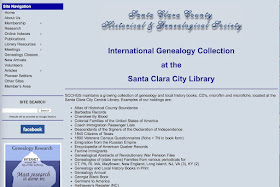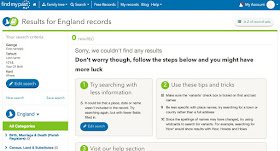Genealogists encounter a lot of surnames since the number will increase with each succeeding generation of ancestors. It is always a good idea when starting out with your genealogical research to have a basic understanding of the surname usage in the country where your ancestors lived. Quoting from the
In the English language speaking parts of the world, a surname is usually synonymous with a "last name," or "family name," or the name written at the end (reading from left to right) of the person's name. The order of the surname can vary around the world. Again quoting from the Wikipedia article:
I wonder how many researchers have made the mistake of failing to consider regional naming order?
Inexperienced genealogists often focus on the spelling of this surname and use variations in spelling to differentiate the relationship between individuals. In addition, while interesting, the origin or meaning of certain surnames is usually not useful in determining relationships except with very specific or rare surnames. In fact, some surnames, such as my own, developed independently in different languages and different countries. There are Tanners in Switzerland and in England.
The standardized spelling of surnames depends entirely on the literacy level of the population and in most European countries and in America, standardized spelling is not common until towards the end of the 19th Century.
There are also some significant variations in the way surnames are formed. For example, historically, almost every language and culture of the world used patronymics as a naming pattern, i.e. the use of the father's given name as a surname with a relationship marker such as the European markers -son, -sen, mac-, -is, and -iz.
If you really want to understand surnames and names in general, here is a list of books on the subject.
Black, George Fraser, and Mary Elder Black. The Surnames of Scotland: Their Origin, Meaning, and History, 2015.
Bowman, William Dodgson. What Is Your Surname?: Surnames, Their Origin and History. London: Faber and Faber, 1932.
Bruner, Gerald J. The Bruner-Robinson Family History and Genealogy: Surnames: Paternal-Bruner, Riggins, Owens, Simpson, Slinkard, Wentz ; Maternal-Robinson, Fisher, Winkler, Crites, Neiger. Franklin, NC; Blakely, GA (P.O. Box 705, Blakely 39823): Genealogy Pub. Service ; Correspondence and orders to Gerald J. Bruner, 2006.
Burmaster, Sandra Lee Sporter. Family History, Surnames of Hilf, Canair/Knorr, Miller ... Margate, Fla.: Place of publication not identified S. Burmaster, 1980.
Clark, Gregory. Son Also Rises: Surnames and the History of Social Mobility. Princeton University Press, 2060. http://public.eblib.com/choice/publicfullrecord.aspx?p=1562740.
EWEN, Cecil Henry L’Estrange. Additions and Corrections to A History of Surnames of the British Isles ... May 1946. (Reprinted.). Baltimore, 1969.
Ewen, C. L’Estrange, and C. L’Estrange Ewen. A History of Surnames of the British Isles: A Concise Account of Their Origin, Evolution, Etymology, and Legal Status. Baltimore; Clearfield, 1995.
Fiennes, Joslin. The Origins of English Surnames, 2015.
Finlayson, James. Surnames & Sirenames: The Origin and History of Certain Family & Historical Names ; with Remarks on the Ancient Right of the Crown to Sanction and Veto the Assumption of Names. And an Historical Account of the Names Buggey and Bugg. London: Simpkin, Marshall and Co., 1863.
Haskett-Smith, W. P. Surnames. London: Society of Genealogists, 1917.
Kephart, Calvin. Origin of Heraldry in Europe, Also of Miscellaneous Surnames and Insignia: A Contribution to Genealogy and History. Baltimore: Heraldic Book Co., 1964.
MacLysaght, Edward. The Surnames of Ireland. Dublin: Irish Academic Press, 1978.
Mansfield, G. M. Family History Index: A List of Less than Common Surnames Found in 25 Selected Family Histories. Salt Lake City, Utah: Filmed by the Genealogical Society of Utah, 2001.
McKinley, Richard. History of British Surnames, A. Hoboken: Taylor and Francis, 2014. http://public.eblib.com/choice/publicfullrecord.aspx?p=1688934.
Paxinos, George. Passage to Ithaca: History, Surnames, Identity, 2012.
Redmonds, George, Turi King, and David Hey. Surnames, DNA, and Family History, 2015.
Rowlands, John, and Sheila Rowlands. The Surnames of Wales. Baltimore, MD: Genealogical Publishing Company, 2014.
Weaner, Arthur, and William F Shull. History and Genealogy of the German Emigrant Johan Christian Kirschenmann Anglicized Cashman: With References to Other Cashman Surnames in America of German, Irish, Jewish, Other and Unknown Origins. A. Weaner Press: Gettysburg, Pennsylvania, 1957.
Weaner, Arthur, and William Frederick Shull. History and Genealogy of the German Emigrant Johan Christian Kirschenmann, Anglicized Cashman: With References to Other Cashman Surnames in America of German, Irish, Jewish, Other, and Unknown Origins : Documented, Illustrated, Indexed. Gettysburg, Pa.: Priv. Print. by A. Weaner, 1957. http://persi.heritagequestonline.com/hqoweb/library/do/books/results/shortcitation?urn=urn:proquest:US;glhbooks;Genealogy-glh51721504;-1;-1;&letter=H.
Whyte, Donald. Scottish Surnames and Families. Edinburgh: Birlinn, 1996.









 [Source: U.S. Census Bureau]
[Source: U.S. Census Bureau]



























